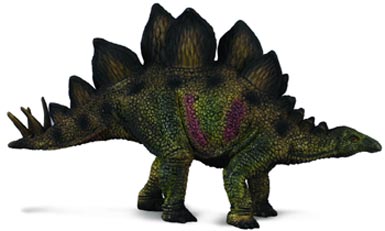Working on Stegosaurus
Revising Stegosaurus
Stegosaurus might be one of the best known and very recognisable dinosaurs but a recent revision of the fossil material ascribed to the genus has led to a shuffling of the Stegosaurus fossil collection. Team members at Everything Dinosaur have let the palaeontological dust settle and then re-visited their own dinosaur database to ensure that what information they carry approximates to the recent changes in this genus. It is time to get working on Stegosaurus once again.
A Model of the “Classic” Stegosaurus
Picture credit: Everything Dinosaur
Working on Stegosaurus
Although more than a dozen stegosaurids have been named, the history of the actual Stegosaurus genus and the species that are included within that genus is a little muddled. The first Stegosaurus was named and described at the height of the great American Marsh and Cope bone wars. It was Othniel Charles Marsh who actually named the first Stegosaurus and erected the genus, this was back in 1877.
The Stegosaurus Genus
All the fossils, (so far as we at Everything Dinosaur know), that are ascribed to the Stegosaurus genus, come from various stratigraphic layers that make up the famous Upper Jurassic Morrison Formation of the western United States.
However, the first confusion with this genus, followed a couple of years later when Marsh’s rival named another stegosaurid Hypsirhophus from fossil material retrieved from the upper most layers of the Morrison Formation in Colorado.
The validity of the Hypsirhophus genus has been challenged, the fossils ascribed consist of fragmentary pieces of vertebrae and some authors have suggested that these fossils represent a dinosaur referred to as Stegosaurus armatus, itself a nomen dubium. Other palaeontologists have agreed with Cope’s original assessment that the Colorado fossils represent a different genus.
In the late 1870s and early 1880s a number of species of Stegosaurus were described. However, recent revisions, (the last one was 2013), have led to a number of these species also being declared nomen dubium (not valid) or regarded as being junior or senior synonyms of other better known species.
Species of Stegosaurus
Currently, only three species are recognised, but work is ongoing and we expect further revisions to the genus in the future.
- Stegosaurus ungulatus – the largest species currently recognised and known from Wyoming (Upper Jurassic, highest stratigraphic zones of the Morrison Formation).
- Stegosaurus stenops – this species has the most complete fossil record, with more than sixty specimens ascribed, including the remarkably well preserved “Sophie” currently being researched by the London Natural History Museum.
- Stegosaurus sulcatus – named by Marsh in 1887 and distinguished from other Stegosaurs by having such robust bases to its tail spikes. The largest spikes thought to come from the tail, may not be tail spikes at all but some form of spiky shoulder armour such as that found in related Thyreophora such as Miragaia.
Stegosaurus is Often Featured in Teaching About Dinosaurs in Schools
Picture credit: Enan
Different Stegosaurus Species
Stegosaurus may be extremely well-known to members of the public, but we still have a lot to learn about these “roofed lizards”,
The Meaning of the Stegosaur Species Names
S. stenops = “narrow-faced roof lizard”
S. ungulatus = “hoofed roof lizard”
S. armatus (nomen dubium) = “armoured roof lizard”
S. sulcatus = “furrowed roof lizard”
To view a range of Stegosaurus models in various sizes: Models of Stegosaurus and Other Prehistoric Animals.



